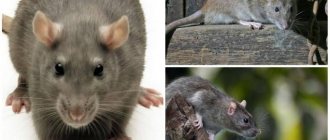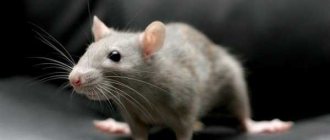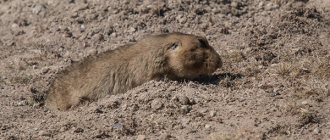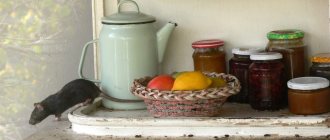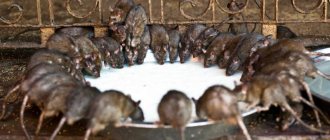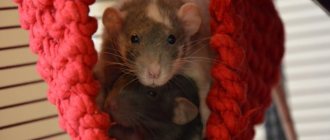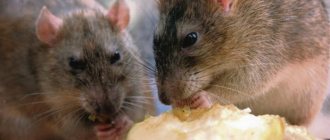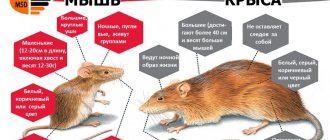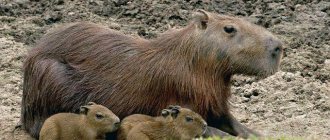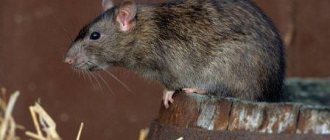Rats can eat any food and are prone to overeating. Therefore, they can quickly gain unhealthy weight. This can lead to serious illness.
If you want your rodent to remain healthy, you need to monitor its weight. It is important to know the standard parameters of rats to determine whether the animal is developing properly and what its health status is.
What determines the size and weight of rats?
The body weight and size of a rodent depends on several factors:
- The species to which the animal belongs. For example, small rats (Rattus exulans) weigh about 70 g and are only 14 cm long. But pasyuks, which are familiar to humans, grow to 20-25 cm and gain a weight of 200-390 g.
- Gender of the rodent. Males, both in nature and among ornamental representatives of this species, are approximately 10-15% larger than females.
- Hereditary data. If the cub's parents are small, then it is unlikely that it will grow into a large rat. This also works in the opposite direction. In large individuals, the appearance of small offspring indicates some kind of pathology or unfavorable factors during the female’s pregnancy.
- Food and living conditions. The ability to obtain adequate nutrition directly affects how much a rat will weigh. If during pregnancy the female does not receive adequate food, the offspring will be more frail. Vitamin and mineral deficiencies during infancy also affect adult size. The animal will be weak and noticeably smaller than its fellows.
- A calm, comfortable environment has a beneficial effect on the weight of animals. A state of constant stress can inhibit development in small rodents.
- Health. The size of an adult rat is directly related to the condition of its body. Of course, it will not become larger than the parameters assigned to it by nature, but excessive thinness and weight loss are direct evidence of an illness in the animal.
Homemade
Measuring the mass of a rodent is simple; just place it on some sensitive scale. Kitchen ones are also suitable. But there are problems with measuring length. The plastic structure allows them to both stretch the body and compress it. The difference in numbers will be colossal.
How to distinguish old animals from young individuals?
Pet rats can live up to 3 years, but for most of that time they do not change their appearance.
This is one of the reasons why it is not recommended to buy an adult rat, but instead look for young rats that are approximately 6 weeks old. Not only is an adult rat more difficult to socialize, but they may not live long, which can be heartbreaking, especially if this is your first pet rat. Typically, the following factors indicate the age of an animal:
Rat teeth color
When a rat's teeth appear, they have a yellow tint. However, over time they become a little darker and the teeth turn orange in old age.
However, it is possible that you have found a rat with natural orange teeth rather than a rat whose life is coming to an end. But think twice before picking up a rat with orange teeth, as it may leave you too soon.
A rat's diet and general health can also affect the coloration of its teeth, and even a young rat may have orange teeth under certain circumstances.
Rat fur quality
Rats are quite finicky animals; they like to be clean and well-groomed. This means that you can often tell how old a rat is by the condition of its fur.
If it has a smooth, silky coat that looks shiny and beautiful and is mostly even in length, the rat is probably less than 6 months old (or possibly 9 months old for females).
As rats mature, they go through the equivalent of puberty. Their fur becomes coarser and less silky, and this occurs more dramatically in male rats than in female rats. In old rats, that is, older than 18 months, the fur may be coarse or absent.
If a rat has orange teeth and its fur is in poor condition, it can be assumed that the animal is at retirement age.
The largest and smallest rats in the wild
Species of rats differ among themselves in their habitat (some prefer to live close to humans, others far away), in size, and taste preferences. People have known some of the representatives of rodents since ancient times, and some they met quite recently.
- The giant Papuan or Bosavi woolly rat does not even have a scientific name yet. It was discovered in 2009 on the island of Papua, which belongs to the territory of New Guinea. It received its temporary name due to the crater of the Bosavi volcano, where it was discovered. Perhaps it can be considered one of the longest rats, since the size of the body reaches 1 meter, plus a tail of about 30 cm.
- Cane rats or bristle pigs are real giants. Despite the body length of 55-60 cm, the weight of females reaches 4-5 kg, and in males it can reach up to 9 kg. They live in equatorial and southern Africa.
- In Russia, the largest breed is the pasyuk or gray rat . Its body length is 17-25 cm, and its weight is 140-390 g.
- The size of the smallest rat found in the wild barely reaches 11–15 cm, weight from 40 to 80 g. The little ones live in New Guinea, the Pacific Islands, and Southeast Asia. In addition to the official name - small , they are also called Pacific or Polynesian .
Children's legends about mutant rodents that appeared due to environmental problems do not have any supporting facts.
Rodent squad: general characteristics and features
The closest relatives are rabbits and hares, forming the order Lagomorpha.
Features of the structure:
- Teeth. Distinctive features are the long upper and lower pairs of incisors, which do not have roots and grow throughout the animal's life. Elongated incisors are needed for gnawing hard food.
- Dimensions. Most representatives of mammals are small in size: from 5 cm to 50 cm. The exception is the largest representative of the species - the capybara, whose length reaches 130 cm, weight up to 91 kg.
- Skeleton. Features of the skeleton are a stocky build, hind legs longer than the front, and a long tail. The tail of some individuals may be significantly longer than the body.
- Digestion. Due to feeding on rough plant foods, rodents have long intestines. They have a cecum, where food is processed through fermentation.
This type of mammal is not whimsical and does not require special knowledge or skills in care, so rodents are often chosen as pets.
Features of care:
- Housing. It must be remembered that most rodents are active animals. The cage should be spacious and kept clean. Removal of food debris and washing of the sippy cup is carried out daily. Cleaning the floor and cleaning the litter - once a week. Once a month you need to disinfect the cage.
- Dental care. There should always be wooden sticks in the cage so that the pet can grind his teeth, which are constantly growing, on them.
- The washing up. You need to place a container with fine sand in the cage so that the animal can clean its fur.
- Situation. Rodents are shy and sensitive creatures, so housing, if possible, should be located in a secluded place, protected from the hustle and bustle.
The numerous species of rodents make their classification extensive. The rodent order has 5 suborders:
- protein-like;
- mouse-like;
- porcupines;
- spiny-tailed;
- beaver-like
Classification: more about suborders
- Squirrel-like. Members of the suborder include squirrels, chipmunks, marmots, and flying squirrels. They live mainly in forests, have strong muscles of the lower jaw, this allows them to gnaw and break solid food. Most representatives of the suborder are omnivores.
- Mouse-like. You can most often meet representatives of this family in everyday life. These include mice, rats, hamsters, voles, lemmings, jerboas, and muskrats. Most of them are nocturnal and feed on seeds and grains.
- Porcupines. The group includes agouti, porcupines, mole rats, nutria, chinchillas, and capybaras. Most representatives of this class are large species with a heavy, rather awkward physique. They are characterized by modified hair into coarse bristles or needles.
- Spiny-tailed. There are nine species, including spiny-tailed squirrels, Pela spinytails, long-eared spinytails, and Cape striders. These animals got their name because of their tail, which is partially devoid of fur and covered with pointed scales. Some members of this suborder, with the exception of the spiny-tailed squirrels, have flight membranes that allow them to glide.
- Beavers. There are about 100 species from 3 families: beavers, gophers and pouchhoppers. Scientists identified it as a fairly young detachment only in 2005. This class includes large rodents with cheek pouches and strong limbs.
The largest city rats
City rats are the same animals that live in rural areas. For a long time, black representatives of this family settled in the attics and basements of houses, lurked around the streets and spoiled the supplies of the townspeople, and served as a source of various diseases. In the 18th century, gray rats began to spread from port cities throughout Europe. Larger, aggressive, eating not only grain reserves, but also meat products, they became a disaster.
A big street rat could drag away a chicken, attack a small child, and, driven into a dead end, bravely fought with cats and dogs. Gradually displacing black rats, pasyuks began to spread throughout all the countries where people live. The most important thing for these animals is the availability of water and food. The only place they avoid is heights. It is almost impossible to meet them on the upper floors of skyscrapers. That's why there are still black rats there, which prefer dry attics. The native element for gray rodents is basements, communications, metro lines, sewers.
Wild animal
Any measures to destroy pasyuks only temporarily reduce their colonies. Smart animals with a clearly constructed hierarchy and defined roles within the group never risk the entire flock. They quickly learn to avoid any human traps and can temporarily leave dangerous territory. But as soon as the colony grows, everything will return to normal.
Grooming
They constantly need to comb their white fur, and they also need to be washed constantly. To comb the rodent, use a toothbrush, and be sure to have a soft one. While combing, you will have to hold the rodent with your thumbs and forefingers.
If you find yellowness in your pet's fur, then this is a reason to worry. It is possible that your rat is sick and is unable to care for itself.
Important! You should not risk the animal's psyche if you decide to clean the fur by washing it in a basin. You can simply wet cotton pads and wipe your pet's fur
After the procedure, you need to wipe the rodent dry.
Place the cage with the animal away from direct sunlight, as white rats are afraid of bright sunlight.
Size and weight of pet rats
Artificially bred decorative rats are increasingly winning the love of humans. Having been born less than 70 years ago, thanks to a strict selection of producers, we managed to obtain affectionate, peace-loving and intelligent animals. Breeders, taking advantage of the rapid emergence of the next generation in these rodents, are excitedly developing new breeds.
Despite the fact that pets are all approximately the same size, there are several species with the largest rats.
- Brown. On average, the animals weigh 500-600 g, but some specimens reach 900 g. Although this cannot be called the norm. It is possible that the rodents are obese. Representatives of this species live only two years.
- Standard. One of the most common breeds. Affectionate and non-aggressive rodents rarely bite despite their very large size for an ornamental rat. They weigh up to 500 g, body length is about 30 cm.
- Dumbo. Representatives of this species were bred in California. Their large protruding ears give their faces a funny expression. The value of a breed representative is determined by the length of the ears. They grow up to 20 cm and gain a weight of about 400 g.
Population and species status
Since the beginning of the third millennium, black rat populations have declined markedly and become fragmented. According to experts, black rats have begun to be replaced by more fertile gray rats (pasyuki). And yet, despite the high fertility, rat populations do not go beyond the “Red Line”, since their numbers are controlled by a number of important factors.
Firstly, the number of these animals directly depends on the availability of food and shelter. Lack of food immediately leads to a decline in population. In addition, there are special rat control services. The number of these animals is constantly declining as a result of certain diseases, as well as hunting by many predators. Therefore, despite their high fertility, which leads to constant surges in their numbers, natural factors, as well as rat control services, are doing their job.
Today, most species of rats are not even close to the risk zone, although there are very rare species that are protected. As a rule, the number of rare species largely depends on the life activity of people, who are developing more and more new territories that are related to the natural habitat of these species.
Franklin Island is home to a very rare species of “House Rats.” Due to the fact that the species lives in a limited area, it is classified as an endangered species. Currently, only about 2 thousand individuals live in this territory. Annual deforestation and fires can reduce kangaroo rat populations.
Average size of baby rats based on their age
Rats are born blind, without fur and with closed ears. Weight at birth is only 4-6 g. Thanks to the mother's nutritious milk, babies grow quickly, adding 2-3 grams every day.
Already on the 10th day of life, they hear well, are covered with fluff, and begin to actively explore the available space. Their body weight increases 6 times during this time.
After 20 days from the moment of birth, rats become similar to adults and grow to a size of about 15 cm.
On the 25th day, the babies are separated from their mother, otherwise the female will independently expel the offspring from the nest into an independent life.
Active growth of young animals continues up to 6 months, but a rat can reach its maximum size only by the age of one year.
Young animals
Approximate weight of the animal depending on age:
- Newborn – 4–6 years.
- 2 months – 160–220 g.
- 3 months – 210–310 g.
- 4 months – 250–430 g.
- 5 months – 300–540 g.
We must not forget that the given indicators are averages, according to which you do not need to adjust your pet. If the animal is active, feels great, and its fur is shiny, then there is no need to try to feed it more high-calorie food or, conversely, limit its food intake.
How long after birth can you pick up
Seeing small newborn lumps swarming around an adult female, you just want to pick them up or at least touch them. Under no circumstances should this be done. Firstly, their body is still very fragile and the slightest wrong movement or compression can lead to injury to the baby. Secondly, after you hold the baby in your hand, its coat will acquire a specific human smell. Mother rats often abandon such babies: they stop taking care of them, don’t feed them, and don’t keep them warm. The result is inevitable death. Despite all the caring behavior of females towards their offspring, they can kill a baby that emits an alien odor.
You will be interested to know what to do if decorative rats fight among themselves.
By three weeks, babies already look strong enough and can eat “adult” food. Even if the female does not want to accept a cub that smells like a human, it will be able to live and feed on its own. Experienced rat breeders recommend not delaying the taming of decorative rats. When the animal is a month old, it needs to be taken as often as possible, then the baby will be more obedient and affectionate.
Should you be afraid of giant rats?
Despite their size, giant breeds of rats are harmless and harmless to people; most individuals feed on fruits, insects, and plant foods. Rodents do not have the goal of attacking humans; moreover, they easily make contact with people and get used to them.
The only time to be wary of rats is when they move in packs. Their flocks consist of more than 100 individuals, which can attack in self-defense. But fortunately, it wasn’t easy to come across a whole pack of rats.
We dealt with the rats. What do you know about spiders? We have selected for you interesting photos and videos about the largest spiders in the world.
Giant rats: myth or reality
Surely each of us has heard creepy stories about giant rats living in abandoned buildings and subways. There are a huge number of articles in newspapers and magazines, and people, reading such stories, believe in it and are really afraid that one day they will meet a mutant rat in person and will definitely take it to their home.
In fact, these are all unconfirmed myths, and the press uses them to attract readers and increase demand for their magazines and newspapers.
The largest rat in Russia is the pasyuk, its size does not exceed the size of an ordinary cat. Of course, their dimensions can be quite impressive, but this is not the result of a mutation, but simply an abundant diet. Pasyuk is definitely not a bloodthirsty monster and does not attack people. Therefore, you shouldn’t believe in mutant rodents, much less be afraid of them.
Danger to humans
The confrontation between humans and rats has lasted for thousands of years. In our time, such a struggle has received an official name - rodent control. Despite its notoriety in Europe and many other countries, including the Americas, in some countries of the East this rodent received the status of a divine animal that symbolizes wealth, wisdom, prosperity, etc. The negative image of this rodent is associated with several plague epidemics in Europe, which were carried by rats.
Important point! Rats are involved in serious economic losses that are associated with spoilage and consumption of various types of goods, both food and other purposes. These rodents damage the insulation of electrical networks, which leads to fires that claim the lives of many people, not to mention damage to property.
Some species of rats cause serious damage to agricultural crops because they simply destroy crops. Therefore, in such conditions, people resort to various methods of protecting crops from rodent invasion. In some cases they are simply scared away, and in others they are physically destroyed. Currently, rats pose a serious threat to the health of all humanity, since these rodents carry pathogens of dangerous diseases. The danger of their vital activity also lies in the fact that these rodents are able to completely unnoticedly penetrate into a human home through sewage and ventilation systems.
Despite the constant and serious fight against rats and other rodents, it has not yet been possible to completely destroy them, but it is still possible to control the populations of these pests.
Experts have established certain norms for deratization, which is associated with the optimal percentage of freeing the territory from rodents.
Therefore it is considered:
- 80% – the result is satisfactory.
- 90% is a good result.
- 95% is an excellent result.
In this regard, it is generally accepted that the task of special deratization services is to maintain in a certain area an acceptable percentage of rodents that would not be able to cause much damage to human life.
